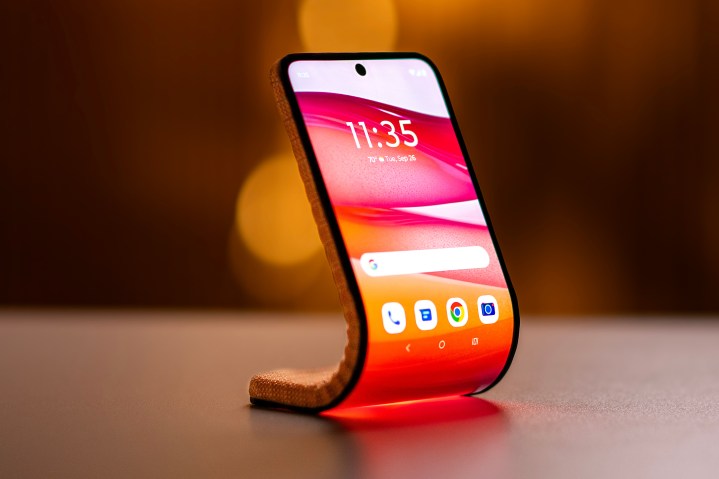
It’s a handsome orange phone. And a smartwatch. And a smart display. And it also looks like one of Microsoft’s Surface Arc mice. In fact, I also see a beautiful at-a-glance smart screen that can keep phone distractions at bay in a tent mode. Actually, all of those things are bundled into Motorola’s latest concept phone.
At the Lenovo Tech World 2023 gala, the Chinese electronics giant came out all guns blazing in terms of AI and hardware innovation, but nothing grabbed as many eyeballs as its bendable phone-smartwatch hybrid concept. And it looks like Motorola is very much looking at it as an Android device with a form factor that also chases wristwear versatility.
“The adaptive display concept can be adjusted from a standard Android phone experience in a flat position to being wrapped for a wrist-worn experience or positioned in several stand modes,” says the company. It further adds that the concept device can run the full
However, it’s the clever use of the clock widget on the home screen and lock screen that really shows off the smartwatch credentials. Look, an argument can be made here that I don’t want a giant screen on my wrist. And it makes perfect sense. Then there is the question of wrist thickness. If the girth is thin, you get a loose grip. For those blessed with thick wrists, you won’t get a secure grip to keep the device in place.
Make it happen, Motorola!
But even if you take the wearable appeal out of the equation, we are looking at a perfectly serviceable folding phone, albeit one that bends outward. That’s where it shines, with various adjustments alongside its mid-half and two-thirds geometry. As you can see in the first image, it can be a great glance screen with a bit of customization done to it. Maybe, something like OnePlus’ Zen mode or the Focus system on iPhones. Also, if the design rings a bell, that’s because Lenovo attempted a strikingly similar device with the cPlus concept back in 2016.
Also, if you notice the ribbed back, those are apparently folding points that allow the device to bend at different seams and stay locked in that position. In its natural state, we are looking at a 6.9-inch FHD+ plastic OLED panel, which can be bent to achieve a practically usable 4.6-inch panel in standing mode.

Now, as is the case with concept phones, never invest your hope in them unless it becomes real. Motorola won’t say if it intends to turn its strikingly stylish concept into a commercial device. But the brand certainly has all the recipes at its disposal to make it real.
The company has been making foldable phones for years. And surprisingly, it has done a better job with their durability than Samsung’s foldable phones. In fact, the company is ahead of the competition and has already showcased a functional device with a rollable display. It’s called the Rizr and it happens to look extremely appealing.
There is no better era for Motorola to attempt an ambitious device like this and make it with gusto, unlike the dud that was the Nubia Alpha. It’s more a question of “will it” instead of “can it.”
As for me, I’ve never wanted a concept phone to get a taste of reality as much as do with this one.
Editors' Recommendations
- Heineken, the beer company, just launched a phone
- 5 phones you should buy instead of the Google Pixel 8
- Motorola’s new Android phone looks amazing, but there’s a catch
- I’ve had the iPhone 15 Pro for six months. Here’s why it’s still amazing
- iOS 18 could make my iPhone look like Android, and I hate it




